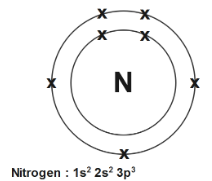
State the electronic configuration for Nitrogen
Answer
454.2k+ views
Hint: As we know, atomic number is total number of a proton present in a nucleus of atom as well as atomic mass number is total number of a proton along with neutron. Nitrogen differs from other elements of the group
Complete step-by-step answer:The atomic number of nitrogen is

So the nitrogen has an atomic number
Therefore, the electronic configuration of Nitrogen is
Note: Note that atomic number of nitrogen is
Complete step-by-step answer:The atomic number of nitrogen is

So the nitrogen has an atomic number
Therefore, the electronic configuration of Nitrogen is
Note: Note that atomic number of nitrogen is
Latest Vedantu courses for you
Grade 10 | MAHARASHTRABOARD | SCHOOL | English
Vedantu 10 Maharashtra Pro Lite (2025-26)
School Full course for MAHARASHTRABOARD students
₹33,300 per year
Recently Updated Pages
Express the following as a fraction and simplify a class 7 maths CBSE

The length and width of a rectangle are in ratio of class 7 maths CBSE

The ratio of the income to the expenditure of a family class 7 maths CBSE

How do you write 025 million in scientific notatio class 7 maths CBSE

How do you convert 295 meters per second to kilometers class 7 maths CBSE

Write the following in Roman numerals 25819 class 7 maths CBSE

Trending doubts
State and prove Bernoullis theorem class 11 physics CBSE

What are Quantum numbers Explain the quantum number class 11 chemistry CBSE

Write the differences between monocot plants and dicot class 11 biology CBSE

Who built the Grand Trunk Road AChandragupta Maurya class 11 social science CBSE

1 ton equals to A 100 kg B 1000 kg C 10 kg D 10000 class 11 physics CBSE

State the laws of reflection of light




